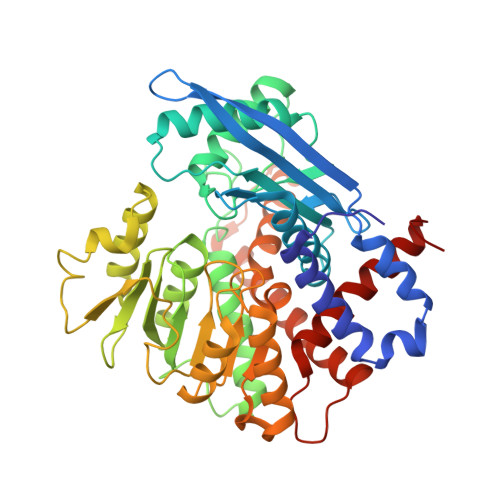Structural basis for the catalytic mechanism and alpha-ketoglutarate cooperativity of glutamate dehydrogenase.
Prakash, P., Punekar, N.S., Bhaumik, P.(2018) J Biol Chem 293: 6241-6258
- PubMed: 29540480
- DOI: https://doi.org/10.1074/jbc.RA117.000149
- Primary Citation of Related Structures:
5XVI, 5XVV, 5XVX, 5XW0, 5XWC - PubMed Abstract:
Glutamate dehydrogenase (GDH) is a key enzyme connecting carbon and nitrogen metabolism in all living organisms. Despite extensive studies on GDHs from both prokaryotic and eukaryotic organisms in the last 40 years, the structural basis of the catalytic features of this enzyme remains incomplete. This study reports the structural basis of the GDH catalytic mechanism and allosteric behavior. We determined the first high-resolution crystal structures of glutamate dehydrogenase from the fungus Aspergillus niger (AnGDH), a unique NADP + -dependent allosteric enzyme that is forward-inhibited by the formation of mixed disulfide. We determined the structures of the active enzyme in its apo form and in binary/ternary complexes with bound substrate (¦Á-ketoglutarate), inhibitor (isophthalate), coenzyme (NADPH), or two reaction intermediates (¦Á-iminoglutarate and 2-amino-2-hydroxyglutarate). The structure of the forward-inhibited enzyme (fiAnGDH) was also determined. The hexameric AnGDH had three open subunits at one side and three partially closed protomers at the other, a configuration not previously reported. The AnGDH hexamers having subunits with different conformations indicated that its ¦Á-ketoglutarate-dependent homotropic cooperativity follows the Monod-Wyman-Changeux (MWC) model. Moreover, the position of the water attached to Asp-154 and Gly-153 defined the previously unresolved ammonium ion-binding pocket, and the binding site for the 2'-phosphate group of the coenzyme was also better defined by our structural data. Additional structural and mutagenesis experiments identified the residues essential for coenzyme recognition. This study reveals the structural features responsible for positioning ¦Á-ketoglutarate, NADPH, ammonium ion, and the reaction intermediates in the GDH active site.
Organizational Affiliation:
From the Department of Biosciences and Bioengineering, Indian Institute of Technology Bombay, Powai, Mumbai-400076, India.


















